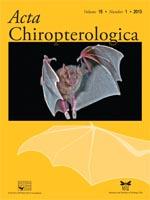Few studies have examined temperatures inside bark roosts of tree-roosting bats. We measured temperatures beneath plates of exfoliating bark of six species of dead trees used for roosting by long-legged myotis (Myotis volans) from June to July 2003–2006 in Idaho and Oregon, USA, and compared these across tree species and with ambient temperature (TA). Temperature profiles beneath bark oscillated within the range of TA, demonstrating the ability of bark cavities on dead trees to insulate against daily extremes in maximum and minimum TA. Slope position affected the difference in bark cavity temperature from TA during daytime periods, with bark cavities on dead trees in upper slope positions being cooler than TA compared to bark cavities on dead trees in lower slope positions. Differences in bark cavity temperatures from TA varied among dead tree species during nighttime periods, with white fir (Abies concolor) and ponderosa pine (Pinusponderosa) warmer than TA compared to other dead tree species. Mean daily maximum temperatures beneath bark of dead white fir, grand fir (Abies grandis), western white pine (Pinus monticola), and ponderosa pine met or exceeded the theoretical lower critical temperature (TLC) of long-legged myotis (range = 29.7–30.5°C) within several hours of sunset, but were substantially colder for much of the day. These data indicate long-legged myotis roosting beneath bark of dead conifer trees likely experience temperatures conducive to use of torpor during early morning hours, with potential for passive re-warming in late afternoon facilitated by increases in daily temperatures beneath bark prior to evening emergence.
How to translate text using browser tools
1 June 2013
Temperatures Beneath Bark of Dead Trees used as Roosts by Myotis volans in Forests of the Pacific Northwest, USA
Michael J. Lacki,
Joseph S. Johnson,
Michael D. Baker
ACCESS THE FULL ARTICLE

Acta Chiropterologica
Vol. 15 • No. 1
June 2013
Vol. 15 • No. 1
June 2013
coniferous forests
Idaho
Long-legged Myotis
Myotis volans
Oregon
roost microclimate
torpor




